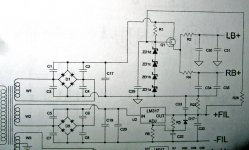Which power supply topology for a SRPP? Voltage regulated or current regulated?
Seems like current regulation has some good attributes: great noise rejection, lower total distortion, and higher gain. Bad attributes: the top tube and bottom tube have uneven workloads.
Voltage regulation may have good attributes: higher total distortion, but the higher-order distortions are lower.
Comments?
Seems like current regulation has some good attributes: great noise rejection, lower total distortion, and higher gain. Bad attributes: the top tube and bottom tube have uneven workloads.
Voltage regulation may have good attributes: higher total distortion, but the higher-order distortions are lower.
Comments?
PS?
You maybe asking which PS is better , tube or solid state? Well solid state is very good if design is good. I prefer regulated PS with Hexfet as the regulator and zenner diodes as voltage references. Ofcourse ultra fast rectifier diodes , low ERS caps (I use MKP 68uF 600v for best results) must be used. Tubed PS are more expensive and they have much higher inner impedance which can be very tricky. Try somthig like this. It has nice feature , the high anode voltage is not activated until the heater of tube is warmed.
You maybe asking which PS is better , tube or solid state? Well solid state is very good if design is good. I prefer regulated PS with Hexfet as the regulator and zenner diodes as voltage references. Ofcourse ultra fast rectifier diodes , low ERS caps (I use MKP 68uF 600v for best results) must be used. Tubed PS are more expensive and they have much higher inner impedance which can be very tricky. Try somthig like this. It has nice feature , the high anode voltage is not activated until the heater of tube is warmed.
Attachments
Well, I know how to build a voltage regulator or current regulator. I'm looking to understand which type of regulator will be best for a SRPP.
A voltage regulator keeps the voltage stable, but allows current to swing.
A current regulator lets the voltage swing, but keeps the current stable.
With an SRPP, which variable should be kept stable, the power supply voltage or current?
Sch3mat1c thinks voltage should be fixed, and current allowed to swing. Is there a good reason why one or the other should be used?
A voltage regulator keeps the voltage stable, but allows current to swing.
A current regulator lets the voltage swing, but keeps the current stable.
With an SRPP, which variable should be kept stable, the power supply voltage or current?
Sch3mat1c thinks voltage should be fixed, and current allowed to swing. Is there a good reason why one or the other should be used?
Hi,
Well, he's right too....
Be it for an SRPP stage or any other topology for that matter you'd want the plate voltage to be stable as that's how the working points for the valves are defined.
Current won't vary much anyway as almost all of these applications will be biased for class A operation so that point is moot.
The SRPP in particular likes to see a clean, stiff PS since it has little PSRR of its own.
Shunt regulation is reported to sound better than series regulation.
Nothing stops you from combining both and take advantage of the intricacies of either one....
Cheers,
Sch3mat1c thinks voltage should be fixed, and current allowed to swing. Is there a good reason why one or the other should be used?
Well, he's right too....
Be it for an SRPP stage or any other topology for that matter you'd want the plate voltage to be stable as that's how the working points for the valves are defined.
Current won't vary much anyway as almost all of these applications will be biased for class A operation so that point is moot.
The SRPP in particular likes to see a clean, stiff PS since it has little PSRR of its own.
Shunt regulation is reported to sound better than series regulation.
Nothing stops you from combining both and take advantage of the intricacies of either one....
Cheers,
- Status
- This old topic is closed. If you want to reopen this topic, contact a moderator using the "Report Post" button.
